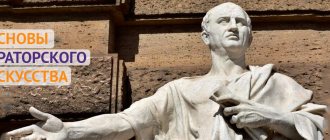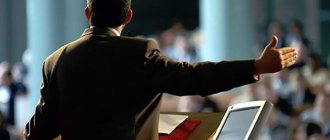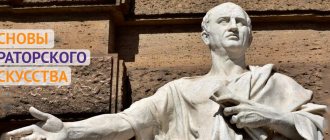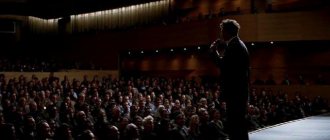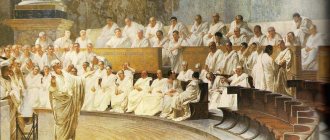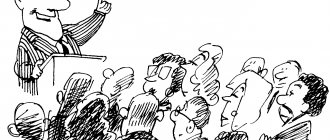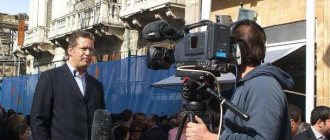About genera and species
In scientific rhetoric, it is customary to distinguish two areas: and specific rhetoric . General considers how the idea (speech, performance, text) is created as a whole and how it is embodied in a statement or in writing.
Private rhetoric (or, as is often said, “numerous private rhetorics”) studies the peculiarities of the construction of speech in different types of verbal art, in different professions, in different fields of activity. The textbook by Nikolai Fedorovich Koshansky, created in the first third of the 19th century, presents the following point of view: “General rhetoric contains the initial, main, general rules of all prose works. Particular rhetoric, based on the general rules, examines each prose composition separately, showing its content, convenient location, main advantages and disadvantages, and purpose.” Despite the fact that almost two hundred years have passed since the publication of this textbook, the definition is still relevant today.
“Figures of speech are a kind of clothing in which thoughts are clothed” (Friedrich Engels)
In a word, “how to structure a speech in front of a large audience?” This is a question from the field of general rhetoric. “How should lawyer Sidorov, who must defend his client tomorrow, structure his speech?” - this is already private rhetoric.
Of course, both of these areas - general and private rhetoric - are inextricably linked with each other. The ideal option is when a person first studies the rules and principles of general rhetoric, and then masters the particular tricks necessary specifically for his profession or specialty. If there are no plans yet to apply what has been learned in practice (for example, a student wants to get acquainted with rhetoric “for himself”), then studying general rhetoric is sufficient for the first time.
As for the various genera and types of private rhetoric, in the modern world one can count many systematizations, each of which is quite harmonious and justified. A fairly popular systematization is based on the division of types of rhetoric into oratorics (from the Latin “to speak”) and homiletics (from the Greek “interlocutor”).
Another word that is most likely unfamiliar to you is homiletics (from the Greek word “interlocutor”, “listener”). This is the name of the theological science of the rules of preaching. This is a narrower concept than rhetoric.
In the first chapter, you may have noticed a sidebar in the margin that discussed the meaning of the word “homiletics,” the term for ecclesiastical eloquence. But sometimes the word “homiletics” also combines those types of private rhetoric that are designed for an entire course of speeches (lectures, sermons, rallies).
For example, a university teacher only in the first lesson introduces students to what and how they are studying, and then only expands and deepens the topic. At each subsequent lecture, he will not reinterpret the goals, objectives, and prospects of the discipline being studied.
Church sermons also have similar features. Thus, the clergyman will not explain to the audience every time what the Bible is or what the Ten Commandments look like. In addition, in most cases, the priest serves in the same parish and more or less knows the main composition of his flock, which means that he does not have to teach those who come the basics of the faith every time. Unless, of course, we are talking about special classes for neophytes.
Sometimes homiletics includes both propaganda activities and the work of the media.
That is, homiletics implies that the speaker and the audience will meet more than once or twice, and each subsequent meeting is partly based on the previous one and precedes the next one. Homiletics serves mainly the development of the spiritual sphere, addressing memory and abstract thinking.
Oratory combines those types of private rhetoric that involve a one-time speech in front of an audience on a given topic: a speech by a lawyer at a court hearing, a speech by a deputy in parliament... Therefore, the speech must be complete and not cause a feeling of understatement. Such a speech can be taken out of the context of the speaker’s activities; it does not require a return to what has already been said in previous times. Of course, there are exceptions here too: for example, if a lawyer has been defending a defendant for several months. But in general, oratory is the art of a one-time speech; it is more practical, “down to earth”, more focused on logic and reasoning.
Sometimes the types of eloquence are simply divided into areas of communication, without dividing them into homiletics and oratorics :
- social and everyday speech. This is, for example, a greeting to the delegation, congratulations to the hero of the day, a memorial speech;
- spiritual eloquence, or church-theological. It is very traditional, largely based on the texts and tenets of the Holy Scriptures or the speeches of spiritual leaders. The classic example is the sermon;
- judicial eloquence, judicial rhetoric - its main types include lawyer's and prosecutor's speech;
- The name “socio-political eloquence” usually includes the speeches of diplomats, military leaders, speeches at rallies and strikes, diplomatic notes, etc.;
- and, finally, academic eloquence, which contributes to the transfer of knowledge from teacher to student, helps the latter form a certain picture of the world. The most striking example here would be a lecture. But a student can also demonstrate his own skills of academic eloquence by presenting an essay, term paper, or report to the public.
As we see, there is no consensus as to what genera and types should be distinguished in the art of rhetoric. Perhaps the simplest and most logical is the division into general and private rhetoric and the study of their specifics.
Regardless of what kind of rhetoric - general or specific - we are talking about, it is customary to distinguish seven main components of speech :
- Introduction.
- Definition of the topic.
- Statement of the essence.
- Proof of your point of view.
- Counterarguments towards the enemy (if there is one).
- Retreat.
- Conclusion.
Introduction
The art of eloquence has been valued at all times among all peoples. “Who are people in awe of? Who do they look at in shock when they speak? Who do they admire? Who is considered almost a god among people? Someone who speaks harmoniously, shining with bright words and images, introducing even into prose a certain poetic meter - in a word, beautifully,” said the great orator of antiquity Cicero.
Russian speaker M.M. Speransky in “The Rules of Higher Eloquence” added: “Eloquence is the gift of shaking souls, pouring one’s passions into them, and communicating to them the image of one’s concepts.”
Without the ability to speak, it is difficult to achieve success in any field: military, diplomatic, commercial. Therefore, even in Ancient Greece, oratory arose (
lat)
art
.
Its synonyms are the Greek word “ rhetoric
” and the Russian word “
eloquence
”.
Rhetoric
is the science of methods of persuasion, various forms of predominantly linguistic influence on the audience. The task of rhetoric from ancient times to today is to educate, delight, and inspire. Influence can be carried out both orally and in writing using arguments and evidence to form new or change old stereotypes of perception and behavior.
Eloquence,
as ancient philosophers noted, it is a way of cognition, interpretation of complex phenomena, it should bring knowledge to people.
It operates with facts, events, figures, putting them into a certain system. Rhetoric uses the discoveries and achievements of many sciences. It is based on psychology, philosophy, logic, ethics, aesthetics and other sciences. Rhetoric
is a science that teaches reasoning, thinking logically, and generalizing. Many speakers were prominent scientists and political figures of their time.
Rhetoric
- this is the art of constructing and publicly delivering a speech, the art of mastering the living word. As an art, it is close to poetry, acting and directing: it studies facial expressions and body movements, teaches you to control your voice and feelings.
The condition for the emergence and development of oratory is democracy, the free participation of citizens in the socio-political life of the country.
From pedagogy to... Toasts
Let us give several examples of how in various types of eloquence (the terms “eloquence” and “rhetoric” in this case are equivalent for us) the tasks that the speaker sets for himself are manifested, as well as what characteristic features these types have.
All of them - some earlier, some later - grew from the common root of ancient rhetoric, from the rules laid down by Aristotle, Cicero and their “colleagues”. Above were examples of different types of eloquence; Let us remember that there are many systematizations.
Richard Wilson. Cicero, his friend Titus Pomponius Atticus and brother Quintus near the villa in Arpinum. 1770s. Cicero's speeches had a huge impact on Roman politics
They do not always make a distinction between academic and pedagogical rhetoric; sometimes they are called additional sections in relation to each other, but there is still a certain difference between them.
The field of pedagogical rhetoric includes the theory and practice of speech communication of a teacher at school, lyceum, and gymnasium.
Pedagogical activity is called “an area of increased speech responsibility,” and this is quite fair - sometimes it depends only on the teacher how interested the students will be in the material, how deeply they will assimilate it and, ultimately, how effectively they will be able to apply their knowledge. Thus, the main tasks of pedagogical rhetoric include developing students’ motivation and awakening their creative abilities.
The following requirements are expressed for the speech of a school teacher:
- it should awaken curiosity;
- it must be logical and at the same time emotional;
- it must be accessible and age appropriate;
- it must be relevant and must meet the needs and interests of students;
- it should not contain controversial statements. (This requirement is controversial in itself—it is often argued that a teacher should present schoolchildren with only verified, scientifically reliable information. But in order to awaken the curiosity of listeners, it is quite possible to invite them to reflect on certain ambiguous theses!)
“As a man is, such is his speech” (Socrates)
Johann Pestalozzi, Maria Montessori, Konstantin Ushinsky, Anton Makarenko, Vasily Sukhomlinsky, Shalva Amonashvili made a great contribution to the development of pedagogical rhetoric. True, the activities of each of them were much broader than just “pedagogical rhetoric,” but if you ever have to prepare a speech in front of a young audience, you will find a lot of interesting things in the works of the founders of world pedagogy.
Vasily Osipovich Klyuchevsky - his wonderful lectures were a huge success both in the “live” presentation of the professor himself and in print
Academic eloquence is characterized by:
- rigid “logical frame”;
- depth of arguments;
- information content;
- using specific terminology characteristic of the chosen scientific field.
The main categories of academic eloquence usually include a report, a lecture in a classroom, a review, and a popular science lecture. During communication with the audience, the speaker can report the results of a scientific search (experiment), generalize the scientific experience of previous generations and present new theories, propose new solutions to existing problems in science, or criticize outdated approaches.
It is believed that this type of eloquence finally took shape in Russia in the 18th century, when Ekaterina Romanovna Dashkova (the first woman to become president of the Academy of Sciences!) asked Catherine II to open public courses in her native language in the main branches of science for everyone. Although, of course, the art of scientific, academic speech existed in Rus' before. Among the outstanding “scientific speakers” and brilliant lecturers are Timofey Granovsky, Vasily Klyuchevsky, Sergei Solovyov, Dmitry Mendeleev, Kliment Timiryazev, Nikolai Vavilov, Vladimir Vernadsky and many, many other famous scientists of the 19th - 20th centuries.
D. I. Mendeleev, in order to make his lectures even better, specially studied the art of rhetoric. Photo from the 1890s
Judicial eloquence (along with political) is one of the most ancient varieties of the art of speech. It is interesting that in the birthplace of rhetoric - in ancient Greece - the accused in most cases defended himself, sometimes, however, turning to the help of professional drafters of legal texts. The speech was usually structured according to the following scheme: the essence of the case - an “artistic” presentation of the event - defense arguments - a vivid conclusion, designed to appeal to the emotions of the court and the audience and sometimes turned into the main element of the speech.
A statement by A.V. Suvorov as an example of “military eloquence”: “One minute decides the outcome of the battle; one hour - campaign success; one day—the fate of the empire"
Over time, lawyers, the institution of juries and other familiar elements of the judicial process appear in both European and Russian practice. Such unsurpassed masters of judicial rhetoric as Fyodor Plevako, Anatoly Koni, and Vladimir Spasovich have gone down in history.
F. N. Plevako is an outstanding lawyer and “court speaker.” Photo 1908
Characteristic features of judicial rhetoric:
- validity of statements (however, this is important in any field);
- impartiality and at the same time deep psychologism;
- logical constructions, polemics;
- analytical approach, in many cases - formalism;
- In addition, judicial eloquence serves the purpose of instilling respect for the law; it is very “civil.”
Legend has it that the lectures of the biologist, physician, physiologist and anatomist Pyotr Frantsevich Lesgaft were so interesting and comprehensive that some students signed up for classes for the second and third time in a row.
The development of political eloquence was closely related to the development of democratic institutions in ancient Greece. Nowadays, this concept has become very broad - it can include informational news blocks, election campaigning, revealing speeches by political opponents, revolutionary calls, and much more. Character traits:
- widespread involvement of the media (after their appearance);
- targeting large numbers of people;
- active involvement of black rhetoric (discussed below);
- as a consequence, a wide range of assessments and levels of information perception. Military eloquence is often considered a subspecies of political eloquence. Indeed, politics without wars, alas, is not always possible, and the rhetorical techniques used by the commander have much in common with the techniques of a politician. Characteristic features include:
- clarity, brevity;
- clarity and at the same time aphorism and imagery (remember Suvorov’s “The bullet is a fool, the bayonet is a good fellow!”);
- trust. The fighters must be imbued with the ideas that the commander wants to convey to them before the battle; A good example would be the words of Peter I, according to legend, spoken by him before the Battle of Poltava in front of a line of soldiers: “And about Peter, know that his life is not dear to him, if only Russia lived in bliss and glory.”
Business communication also has its own characteristics. In relation to rhetoric, here we usually consider speaking at a meeting, negotiations, and presentation. The characteristic features of business rhetoric will be:
- intensity, high “information content”;
- significant expressiveness and at the same time the presence of a framework of business etiquette;
- accessibility, in some cases—formalism.
Social and everyday eloquence (its examples were given above) is distinguished by emotionality, the use of folklore features (for example, a toast), significant improvisation, and freedom of expression. True, if we are talking about “etiquette communication,” for example, about a reception at Buckingham Palace, then the role of templates and strict rules increases immeasurably. However, many attribute “palace receptions” to the political sphere.
Text of the book “Rhetoric. Crib"
Types of eloquence. Typology
In Russia XVII–XVIII centuries. The authors of rhetoric identified five main types of eloquence.
1. Socio-political eloquence - a report on socio-political and political-economic topics, a report, political diplomacy, military-patriotic, rally, oratorical speech, political review.
2. Academic (scientific) and lecture eloquence - lecture, scientific report or review, scientific message or information.
3. Judicial eloquence - prosecutorial (accusatory) speech, lawyer (defensive) speech, self-defense speech of the accused.
4. Social and everyday eloquence - an anniversary, dinner or funeral speech, “small talk” as something easy, natural and pleasant, without discussions, disputes and polemics.
5. Theological-church (spiritual) eloquence - sermon, speech at the cathedral.
Some experts also distinguish disputative-polemical (or dialogical) eloquence - this is an argument, discussion, disputation, polemic, conversation, business meeting, interview, press conference, business game, evening of questions and answers.
Modern oratory is diverse, it can be divided into various genera (sections) and types (genres) depending on the specific scope of application: even Aristotle in his “Rhetoric” divided speeches into deliberative, judicial and epideictic (solemn).
Modern types of oratory.
1. Socio-political eloquence - a report on socio-political and political-economic topics, a reporting report, political diplomacy, military-patriotic, rally, agatha mountain speech, political review.
2. Academic (scientific) and lecture eloquence - lecture, scientific report or review, scientific message or information.
3. Judicial eloquence - prosecutorial (accusatory) speech, lawyer (defensive) speech, public accusatory or public defense speech, self-defense speech of the accused.
4. Social and everyday eloquence - an anniversary, dinner or funeral speech, “small talk” as something easy, natural and pleasant, without discussions, disputes and polemics.
5. Theological-church (spiritual) eloquence - sermon, speech at the cathedral.
6. Diplomatic communication – diplomatic speech etiquette and its mandatory norms, negotiations and correspondence, drafting strict legal documents, simultaneous translation.
7. Military eloquence - combat call, combat order, regulations, military memoirs, radio communications.
8. Pedagogical communication – the teacher’s story and explanation, the child’s egocentric speech, children’s oral stories, their written compositions, children’s literary creativity, a lesson as a complex act of pedagogical communication.
9. Dialogues with oneself (inner speech, mental) - mental preparation for oral and especially written statements, reading to oneself, memories and reflections, internal planning and rehearsal.
Argumentation and logic
In argumentation there are different "thesis"
- a statement (or system of statements) that the arguing party considers necessary to inspire the audience, and an argument, or argument - one or more interconnected statements intended to support the thesis.
An argument
is a speech act that includes a system of statements intended to justify or refute an opinion. Such a system of statements is addressed primarily to the human mind, which has the ability to judge, accept or refute the statement.
Argumentation theory
explores the variety of ways to persuade an audience using speech:
1) through speech and verbally expressed arguments;
2) gesture, facial expressions, visual images, silence in certain cases;
3) violence, hypnosis, suggestion, subconscious stimulation, medications, drugs, etc.
The following features are characteristic of the argument:
1) argumentation is always expressed in language and takes the form of spoken or written statements; argument theory examines the relationships between statements, rather than the thoughts, ideas, and motives behind them;
2) argumentation is a purposeful activity and has as its goal the strengthening or weakening of someone’s beliefs;
3) argumentation is a social activity, it is aimed at a person or a group of people, it involves dialogue and an active reaction of the opposite side to the arguments presented;
4) argumentation presupposes the reasonableness of the subject who perceives it, his ability to rationally weigh arguments, accept or challenge them.
Laws of logic:
1) law of identity.
Each thought in the process of a given reasoning retains the same specific content, no matter how many times it is repeated. All people are mortal. Socrates is a man, therefore Socrates is mortal. This law also requires knowledge of such a science as logic, since in order to fully formulate a statement, it is necessary to trace the entire logical chain of the statement;
2) law of contradiction.
Two opposing thoughts about the same subject, taken at the same time, in the same relation, cannot be simultaneously true. Baikal is the deepest lake. Baikal is the smallest lake;
3) law of the excluded middle.
Of two contradictory judgments (about the same subject), one must be true, the other false; but there is no third option. This equation is simple. This equation is complex. Only one of these two statements will be true, the third is excluded;
4) law of sufficient reason.
Every correct thought must be justified by other thoughts, the truth of which has been proven by practice.
Pathos in oratory
Pathos
(from Greek - “suffering, feeling, passion”) - this is inspiration, enthusiasm, elation. The art of oratory has always been interesting; the orator was recognized as having a special power that allows him to subjugate a person only with the help of words.
Only with the help of perfect knowledge of the laws of rhetoric did the speaker have the opportunity to influence and completely subjugate the consciousness of the people listening to him. Talented speakers became government leaders, great scientists, heroes and masters of thought. A great man does great things.
In order to become a great statesman, one must certainly be able to act with words, that is, to inspire supporters, overthrow opponents and convince the crowd of the truth of one’s ideas.
Oratory
is the ability to deliver public speeches convincingly and effectively.
Oratory
- a field of rhetoric that studies the art and skill of public speaking. Every person finds himself in a situation where he needs to tell something, explain some phenomenon, in a word, construct a detailed speech in public. In such situations, knowledge, education, internal energy, will, initiative, and the ability to find the necessary words and express them in a suitable form are tested. Some people make the most magnificent speeches using knowledge of rhetoric, and some use the techniques of this science on a subconscious level. There is a famous Quintilian formula: “To be a good speaker, you must be a good person.” A true speaker does not care about the temporary success of his speech, he thinks about how his word will respond later.
Each person has an individual speech talent; it is necessary to understand what it lies in, try to reveal and develop hidden capabilities.
One person can write brilliant poetry, another can easily work in production or be a talented manager, the main thing is to be able to understand and notice your talent.
Developing talent involves working on oneself, which consists of increasing the amount of knowledge and increasing education.
The next requirement concerns the uniqueness of the speaker’s personality. Every person is valued as a person who has a unique view on any subject and concept; a true speaker takes a strong position and can defend it.
Defending a position does not imply straightforward stubbornness; on the contrary, a wise rhetorician behaves intelligently and subtly: he knows how to listen to his opponent and defend his own point of view.
Political eloquence
If we talk about political speeches,
then they are:
1) informational, informative - this is propaganda, political education, science;
2) persuasive and appealing, encouraging action - this is campaigning (for example, election campaign);
3) debatable, polemical, even revealing (discussion of controversial issues).
In politics, the media are widely used - radio, television programs; in new moments of intensification of political struggle, the role of the living word and improvisation
- this is speaking at rallies, demonstrations, and finally, in revolutionary acts. These speeches presuppose perfect mastery of the art of speech; only with the help of this is the success of this or that enterprise based on agitation possible.
The range of topics of political speeches is wide: the struggle for power, international and interethnic issues, economic, moral and educational, legal and scientific and educational, religious and confessional problems and the most complex issues of life, everyday life, and providing for people.
In the early 1990s. In Russia, the theme of “the language of power” was clearly heard. The speeches of government officials, major leaders in the economy, education and culture, in the so-called security forces always attract the attention of wide circles of citizens, because these speeches transmitted through the media contain
vital information (the “power – people” model). Unfortunately, statesmen did not always have the opportunity to follow all the rules and laws of rhetoric, although this did not affect their success.
The rhetorical characteristic of this type of political speech is as follows: they are judged by the degree of completeness, “transparency” in the selection of facts, connections between them and prospects. They are perceived ambiguously by listeners and readers; their understanding and assessment always vary significantly.
Another type of political eloquence is the rhetoric of revolutions. They put forward many truly gifted speakers: Che Guevara, G. Garibaldi.
The reasons for this: the deep conviction of the leaders of the movement in the rightness of their cause, the need to attract the masses of people, their convictions, high emotional uplift, inspiration, readiness to sacrifice, proclamation of the struggle for the freedom and happiness of the people, the entire people. Revolutionary oratory is heated to the limit with passions; it excites huge masses of people.
In political eloquence, compliance with linguistic norms is usually noted, and often the use of means of figurativeness and aphorisms. Facts of violation of speech culture are subject to ridicule and criticism. Visual propaganda tools are also used: slogans, posters, banners, portraits, various symbols, as well as music and films. The speeches of political speakers are often published and republished in the form of brochures, books, and even multi-volume collections.
Diplomat's speech
In essence, diplomacy
- This is also politics, but external. These are the activities of civil servants, diplomats, ambassadors, embassy staff, consulates, as well as trade, cultural, and tourism; activity based entirely on knowledge of the political situation and oratory. Diplomatic functions are also performed by members of governments, heads of large departments, parties, firms, educational institutions - all those who have to communicate with foreign states.
Naturally, in diplomacy there are numerous requirements that are less relevant to the areas of speech.
Firstly, the diplomat’s speeches are distinguished by a high sense of dignity, because he represents his country, which has traditions, authority, and often economic and military power.
The diplomat knows how to show high respect to his interlocutors, who also represent their country with its traditions and ambitions.
Without observing the above, the speeches of diplomats are unlikely to give the desired result, mutual interests will not be respected, and agreements will not be reached.
Successful contact is also facilitated by adherence to established, usually traditional, etiquette and ceremonial.
Secondly, the diplomat’s speech should reflect his high education, not only general, but also excellent command of several languages,
deep knowledge of history, culture, geography, economics, literature - the world and especially the country with which negotiations are being conducted. In some meanings, words and phrases of common literary language are used in the language of diplomacy as terms: protocol (a set of generally accepted rules of international communication), immunity (personal inviolability, premises of diplomats), reception (meeting of invited persons and other officials).
Thirdly, a diplomat must have quick reactions, understand a hint, appreciate the wit of others and be flexible and witty himself.
Having mastered the culture of speech not only at the level of the norms of the literary language, he will achieve success with wit, grace, and expressiveness of his speeches.
Even a small mistake, inaccuracy, or contradiction in a diplomat’s arguments is the end of his career.
The diplomat also needs subtle insight in the role of not only the speaker, but also the listener: he must catch the reactions of his interlocutor, unravel the hints and hidden thoughts, as if the background of what is being discussed.
Finally, a diplomat needs to be firm in his position in protecting the interests of his country.
By the way, all these requirements can be useful not only for a professional diplomat, but also for a traveler, businessman, tourist, artist and other representatives of culture, transport workers (air, sea, railway).
It is known that many Russian writers were professional diplomats: A. S. Griboyedov, A. M. Gorchakov, F. I. Tyutchev.
Academic eloquence
Academic eloquence
- this is one of the oldest fields of language search - high skill in communicating with students.
Socrates, Plato, Aristotle
thought about this and in Russia -
V. S. Solovyov, V. O. Klyuchevsky, N. A. Berdyaev, V. V. Vinogradov, K. A. Timiryazev, A. F. Losev, S. Likhachev
and many others. As teachers, these recognized thinkers and scientists formed and honed the skills of educational dialogues, discussions, heuristic conversations at lectures at universities, and at public appearances. The main principles that guided them: the scientific depth of the material presented, accuracy, logic (validity, evidence, search for truth), knowledge and consideration of the addressee, the ability to establish contact with the audience, find the level of acceptability, interest, motivation, and achieve a response developmental effect.
Its distinctive features:
1) scientific terminology;
2) argumentation;
3) logical culture;
4) communication of scientific information that is new to the audience;
5) accessibility.
A university professor provides examples of a culture of thinking; he leads students. After all, it is the professor who shows his students the depth and beauty of their chosen science. The essence of university education is not only in the novelty of what is presented, but also in the implementation of research methods. The professor awakens the students' thoughts, stimulates their abilities, talent, and ignites their aspirations.
A type of academic excellence is pedagogical communication - at school, in the family.
The main thing in such communication is the creation of an atmosphere of intimacy, trust, a favorable emotional climate, the artistry of the teacher, educator, eliminating psychological barriers. However, the teacher still plans his actions in stages: modeling upcoming communication; its organization and execution of what was planned - with possible options, “control” of the course of communication; control and evaluation stage - for yourself, of course. A teacher or educator needs to have impeccable command of himself and language, the mechanisms of speech, to quickly navigate changing conditions, not to miss the main goal, to see in front of him not an object of influence, but a living, moreover, vital personality. Of course, it is necessary to understand the psychology of another person, the ability to find an approach to each student and, through communication, spark interest in the minds of everyone to whom his skills and talent are directed.
In Russia, academic eloquence developed in the first half of the 19th century. Memories of contemporaries have been preserved about such excellent scientist-lecturers as V. O. Klyuchevsky, T. N. Granovsky, S. M. Solovyov, I. M. Sechenov, D. I. Mendeleev, K. A. Timiryazev
and etc.
This type of eloquence overlaps, on the one hand, with political speech, for politics and diplomacy precede war, and on the other hand, with legal, business, and even clerical speech.
The latter is used in the wording of orders, charters and other documentation. All this has a significant impact on the speech of military personnel.
The military theme and style of the heroic epic have a rich history: these are Homer’s Iliad, The Tale of Sigurd, The Song of Roland, and The Tale of Igor’s Host.
In Athens, the military orator Pericles, the strategist (commander-in-chief), became famous. A peculiar rhetoric developed in Sparta: the Spartans valued laconicism and mocked the lengthy speeches of the Athenians.
For example, a mother saw off her son to war with the words: “Come back with a shield or on a shield.” Saying of Lycurgus: “It is safer when a city is surrounded not by bricks, but by warriors (defenders).” The speech of Alexander the Great, a student of Aristotle, is aphoristic.
The famous speaker (and writer) was Emperor Gaius Julius Caesar, in Russia - Peter the Great, Alexander Suvorov.
Suvorov's sayings were apt, aphoristic, and easily remembered by the soldiers. Just a joke, knowledge of the soldier’s language worked wonders, A.V. Suvorov was the favorite of the Russian army.
Specifics of the military profession
- this is strict discipline, high organization, clarity in everything, as a rule, good health, exactingness towards oneself and subordinates, speed of reactions.
All these qualities of a military man are reflected in military narratives, calls and commands that are born in extreme conditions, in the process of training soldiers, and in the preparation of military documentation.
Military eloquence is a unique genre that inherently requires clarity, conciseness, strength and clarity in the construction of statements.
A bright and strong personality, a strategist, an orator - this is the ideal of a commander at all times.
True orators were such brilliant commanders as Henry IV, Gustavus Adolphus, Alexander the Great, Julius Caesar, Frederick the Great, Napoleon Bonaparte, Alexander Vasilyevich Suvorov, Mikhail Illarionovich Kutuzov, Admiral Nelson, who remained in history thanks to their talents.
Spiritual and moral word
The Russian language was formed under the substantive, moral, and stylistic influences of the main book - the Bible and especially the Gospel, psalms, prayers, and liturgical texts.
Most anthologies had sections of up to 50 pages, printed in Church Slavonic.
In the 20th century There are few people left who know the Church Slavonic language, except the clergy. Their speech, even in secular situations, is still distinguished by its original manner, pronunciation, partly vocabulary and phraseology.
In the speech of secular language users, Slavicisms were combined with folk poetic elements, the style of proverbs, ancient songs, epics, and partly literature of the 8th - early 19th centuries.
Features of spiritual and moral speech:
1) speech is leisurely, without raised tones, measured, rhythmic, devoid of emotional outbursts, reasonable, less often - instructive;
2) well-developed vocabulary with unemphasized, moderate articulation of speech sounds, a barely noticeable tendency towards Northern Russian okanye;
3) relatively frequent quoting of well-known biblical sayings, popular sayings
words from the Gospel and other Christian books, and these quotes, as a rule, are organically woven into the speaker’s author’s text;
4) the syntax of speech is clear, the sentence sizes are not too large, usually rounded, and intonationally complete.
The requirements for a culture of speech and compliance with norms are very high; it is focused on secular criteria, but in some cases specific forms are used.
In spiritual and theological educational institutions, attention is paid to voice training, singing, intonation, timbre, memorizing a huge number of texts and their expressive reading, as well as the readiness of the memory at a certain moment to “give” the necessary winged words.
The values of language are preserved in ancient translations of the Gospel.
A special place in the spiritual life of believers belongs to confession, that is, a sacrament to which the word “eloquence” is hardly applicable. Confession
- this is self-disclosure, repentance, repentance, self-purification through truthful confession of bad deeds, thoughts, intentions.
This is a school of truthfulness, sincerity, moral purification of both the individual and the entire society.
Black rhetoric is a game without rules
One of the most popular textbooks on rhetoric in the modern world has become the book by consulting specialist Carsten Bredermeier, “Black Rhetoric: The Power and Magic of the Word,” which has already been republished many times.
“To be clear, a speaker must be frank” (Vasily Klyuchevsky)
What is black rhetoric? The author himself compares speech constructed according to these rules with “verbal mines flavored with arsenic.” A more modest definition of black rhetoric is this: it is the manipulation of all available techniques (dialectics - the art of dialogue, eristics - the methodology of arguing) so that the conversation constantly turns into a direction convenient for us, so that we can “knock out” the opponent, bring the dispute to the result we need.
Everything is allowed! Demagogic techniques, manipulation, distortion - and, of course, emotions, outright bluff and jokes. Of course, with the help of such techniques it is more convenient to disguise one’s incompetence as a speaker, but, according to adherents of black rhetoric, it does not at all mean the ability to get by only with prohibited techniques. On the contrary, the more savvy you are in the issue under discussion, the more prepared your speech is, the more effective the tricks described by Bredermeier will be.
The author believes that rhetorical techniques themselves, no matter how dubious they may look, cannot carry a positive or negative message—it all depends on what goal you set for yourself as a speaker. Play on emotions, throw your opponent off balance, act in a dispute in a way that he does not expect! These are just part of the arsenal of those who set out to use methods of black rhetoric in communication. In part (as you have probably already noticed) this movement has something in common with the sophists of ancient Greece.
What basic rules can be identified?
- You need to express your thoughts clearly, briefly, accurately and figuratively.
- It is necessary to clearly highlight in your speech the main and secondary, the main points of your speech.
- It is imperative to highlight the main idea, which accumulates almost the entire essence of the speech.
- Constantly repeating the main idea, it should “be deposited in the listeners’ subcortex.”
- Present your listeners with contrasts: “Now or never!”, “There is no third option!”
This increases emotionality and distracts from attempts to think critically: in the case of black rhetoric, it is better not to give the listener such an opportunity.
- Erase the line between lies and truth, turn information around in a way that suits you. Even if this technique is exposed, you will attract attention. An example from the yellow press: a newspaper comes out with the headline “The most famous actor N, a favorite of the public, died tragically, shot by his wife’s lover!” And the article talks about how N is simply playing the role of a deceived husband in yet another performance...
- Statements must be targeted. Address the audience confidentially, try to touch their heartstrings, awaken personal memories and emotions. Be sure to “poke in the soft spot” of your opponent as well: this will make him nervous and confuse his thoughts.
Examples of black rhetoric Accusation: “Well, we all know very well that dishonest people work in this company.”
Third-person insult: “If I were your boss, you would be held accountable for your stupidity!”
Refined politeness combined with humiliation: “Ivan Ivanovich, I beg you to forgive me, but at the planning meeting you spoke such nonsense.”
Offering a choice, in which any option will present the opponent impartially: “Did you oversleep for work because you had too much at the club again, or do you just not care about our common cause?” (You can remember the famous “Have you stopped drinking cognac in the morning? Yes or no?”)
Emphasizing one’s high position while simultaneously devaluing it: “Well, let’s take half an hour to see what yesterday’s schoolgirl will teach us...”
This is what it is, black rhetoric. Whether to use such techniques is your own business. This is a matter of morality rather than professionalism (although no one argues that black rhetoric is sometimes very effective). Masters who have made a name for themselves in the field of such eloquence are feared, but are they respected? In addition, it is quite difficult to find the line where teasing (even if offensive) ends and insults and slander begin, for which one can be held accountable to the fullest extent of the law.
